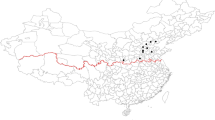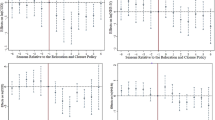Abstract
China began enforcing a system of pollution levies in 1982. However, senior environmental officials expressed doubt that this system was improving the environment and, in 1996, they began to place greater reliance on mill closure as the penalty for poor environmental performance. Since then, managers have found means of subverting many of the intended mill closures, and this causes us to return to the question of the abatement efficiency and effectiveness of the levies. This paper uses production evidence from 34 papermills in two representative provinces to examine the abatement efficiency and effectiveness of the levies. The paper industry is an important industry for this question because it is the largest polluter of China’s rural environment. We use a distance function to determine individual output-based and revenue-based shadow prices for each mill during the years that the levies were the main environmental incentive. The output-based shadow prices for pollutants display no recognizable trends over time and they are very different for firms in different locations. The revenue-based shadow prices are widely variable between mills and locations as well. These findings indicate that the marginal opportunity costs of abatement were also widely divergent and that there was no trend toward improved abatement efficiency. The way to correct this is to improve the performance of the market—not to reject the market altogether as the more recent reliance on mill closures does. This observation suggests that a system of tradable permits would be an improvement on relatively less successful administrative measures such as forced mill closures.
Similar content being viewed by others
Notes
Premier Zhu Rongji, in the Government Report to the National People’s Congress on March 5, 1999, identified sustainable development as one of China's two fundamental strategies for the twenty-first century. President Jiang Zemin, stressed the importance of environmental protection at the annual workshop on Population, Resource and Environment on March 13, 1999.
Output distance functions measure differences in technical efficiency between any one firm and the most efficient firm. They reflect the full production process, not just the abatement response. The full production process is important in our case because China’s policies emphasize end-of-pipe measurement and enforcement. End-of-pipe enforcement encourages the adoption of new abatement technologies, but these are costly and the available technologies were generally developed for North American and European mills of much greater scale. Therefore, China’s mills have turned to managing inputs and outputs within existing technologies as their response to pollution control—and a description of the full production processes is necessary to model this response.
The econometric evidence of Xu et al. (2003) supports this expectation.
Jefferson et al. (1996) review this problem. They too prefer to use net capital stock for their production analysis but they add a term, the ratio of net capital to original capital, to adjust for inflation. We remain uncertain as to what is the best reformulation. Therefore, we replaced our measure of capital with a measure of investment and re-ran our basic production model. There are no fundamental differences between the two equations, and both measures of capital perform as expected.
The policy distinguished between permanent and contract labor. Managers had discretion to release contract labor, but they only began to exercise the option during the economic downturn of 1990. For those with permanent employment, employment was essentially a birthright and cases of excess labor were so extreme that managers paid some laborers to stay home—a sure indication of negative marginal productivity. When the government finally allowed managers to release redundant labor in 1998, managers of state owned enterprises removed seventeen million workers from their payrolls, more than one-fifth of the total labor force of state owned enterprises (Wilhelm 1999; Saywell 1999).
In a separate analysis, we conducted a Chow test comparing the OLS versions of the stochastic frontier functions for the two provinces (using data from 1986 to 1992, the years for which the data are complete). After comparing the Chow value [F(7, 150) = 0.3185] with the critical F value for 95% confidence, we cannot reject the hypothesis that the last seven slopes for conventional production inputs and mill characteristics are similar for the two separate provincial estimations.
We examined other functional forms as well. Functions with time variables performed better.
Output distance values like these measure the loss of physical output per unit reduction of pollutant. They are less comparable across mills employing different technologies and producing different products. Therefore, calculations of their mean values and C/Vs would not be meaningful.
References
CTAPI (China Technical Assocaition of Paper Industry) (1999, 2003) Almanac of China’s paper industry. China Light Industry Publishing House, Beijing
Dasgupta S, Huq M, Wheeler D (1997) Bending the rules: discretionary pollution control in China. World Bank Policy Research Working Paper No. 1761, Washington
Fare R (1988) Fundamentals of production theory, lecture notes in economics and mathematical systems. Springer, Berlin
Fare R, Grosskopf S, Knox Lovell CA, Yaisawarng S (1993) Derivation of shadow prices for undesirable outputs: a distance function approach. Rev Econ Stat 75:374–380
Fuentes HJ, Grifell-Tatje E, Perelman S (2001) A parametric distance function approach for malmquist productivity index estimation. J Prod Anal 15:79–94
Griliches ZVI (1986) Economic data issues. In: Griliches Z, Intriligator MD (eds) Handbook of econometrics, Chap. 25, vol III. North Holland, Amsterdam
Harrington W, Morgenstern R, Sterner T (eds) (2004) Choosing environmental policy: comparing instruments and outcomes in the United States and Europe. Resources for the Future, Washington
Jefferson GH (1990) China’s iron and steel industry: sources of enterprise efficiency and the impact of reform. J Dev Econ 33:329–355
Jefferson GH, Xu W (1994) Assessing gains in efficient production among China’s industrial enterprises. Econ Dev Cult Change 42(3):597–615
Jefferson GH, Rawski TG (1994) Enterprise reform in Chinese industry. J Econ Perspect 8(2):47–70
Jefferson GH, Rawski TG, Zheng Y (1996) Chinese industrial productivity: trends, measurement issues, and recent developments. J Comp Econ 23:146–180
Li W (1997) The impact of economic reform on the performance of Chinese state enterprises, 1980–1989. J Polit Econ 105(5):1080–1106
Lin JY (1992) Rural reforms and agricultural growth in China. Am Econ Rev 82(1):34–51
Pargal S, Wheeler D (1996) Informal regulation of industrial pollution in developing countries: evidence from Indonesia. J Polit Econ 104(6):1314–1327
Qu G (1991) Environmental management in China. UNEP and China Environmental Science Press, Beijing
Saywell T (1999) On the edge. Far East Econ Rev 162(9):46–48
Shephard RW (1970) Theory of cost and production functions. Princeton University Press, Princeton
Tao W, Zhou B, Barron WF, Yang W (2000) Tradable discharge permit system for water pollution. Environ Resour Econ 15(1):27–38
Wang H, Wheeler D (1996) Pricing industrial pollution in China: an econometric analysis of the levy system. World Bank Policy Research Working Paper 1644
Wilhelm K (1999) Out of business. Far East Econ Rev 162(7):10–15
Wong Y (1998) China’s high rate of expansion isn’t without growing pains. Asian Wall Str J XXIII(81):1,4
Xu J (1999) China’s paper industry: growth and environmental pollution during economic reform. Unpublished Ph.D. dissertation, Virginia Polytechnic Institute University and State University
Xu J, Hyde W, Amacher G (2003) China’s paper industry: growth and environmental policy during economic reform. J Econ Dev 28(1):49–79
Yin R, Hyde W (2000) The Impact of agroforestry on agricultural productivity: the case of northern China. Agrofor Syst 50:179–194
Acknowledgments
We would like to thank Knox Lovell, who was generous with his advice and assistance throughout our research on this and related topics, Tommy HuTao and Tao Wendong for their assistance with data collection, and Li Liya for her help with data entry and editing. We also acknowledge the generous sponsorship of EEPSEA and the EfD Initiative launched by SIDA.
Author information
Authors and Affiliations
Corresponding author
Rights and permissions
About this article
Cite this article
Xu, J., Hyde, W.F. & Ji, Y. Effective pollution control policy for China. J Prod Anal 33, 47–66 (2010). https://doi.org/10.1007/s11123-009-0153-7
Published:
Issue Date:
DOI: https://doi.org/10.1007/s11123-009-0153-7




